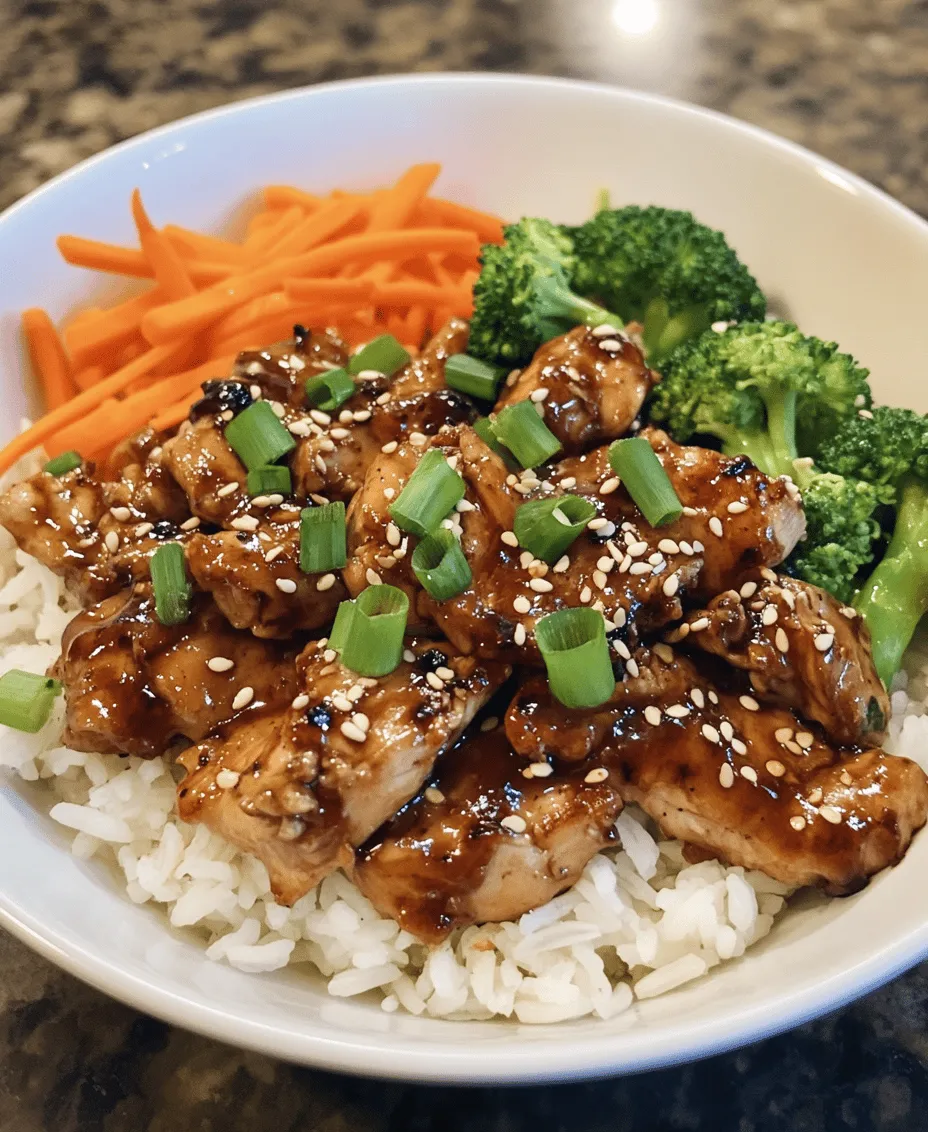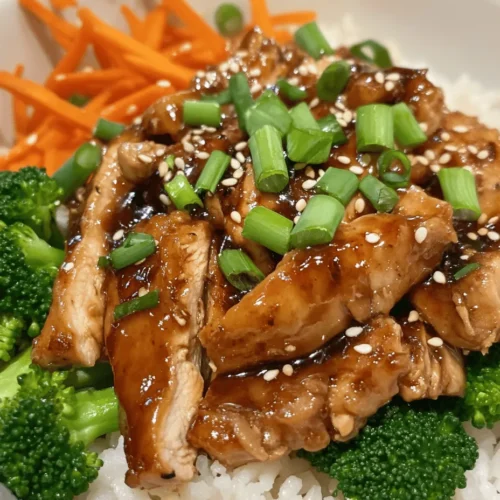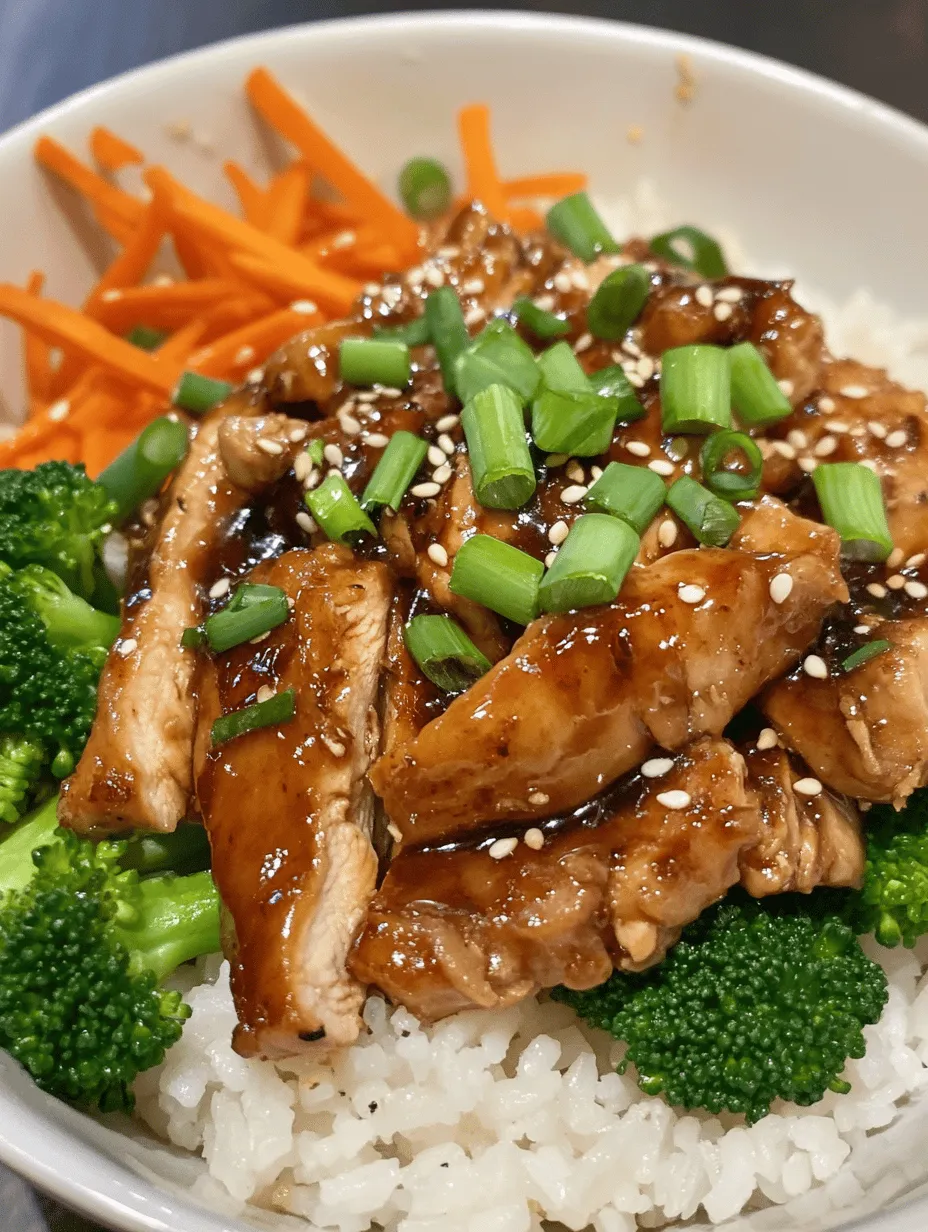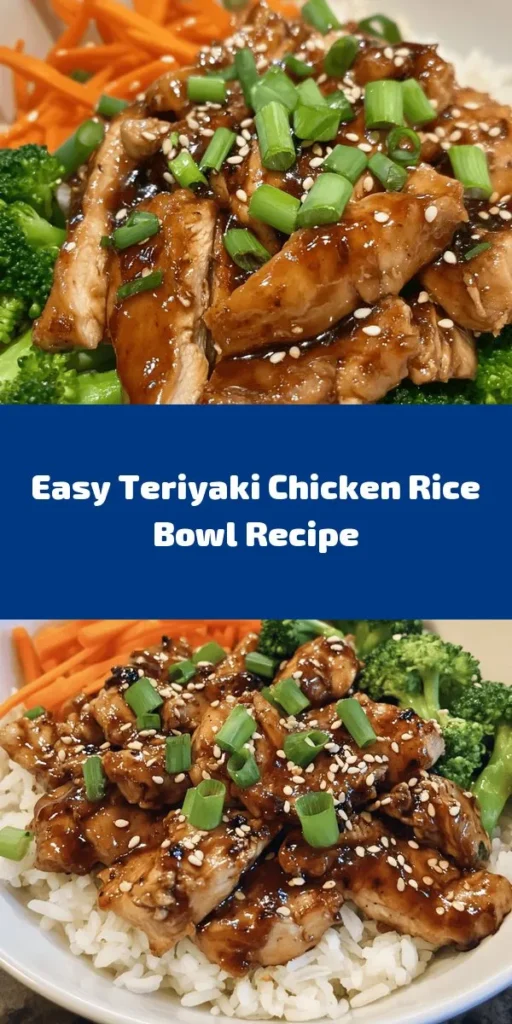Introduction
The Teriyaki Chicken Rice Bowl is a beloved dish that has captured the hearts and taste buds of many food enthusiasts around the world. This delightful meal features tender, marinated chicken glazed in a sweet and savory teriyaki sauce, served over a fluffy bed of jasmine rice, and accompanied by colorful vegetables. It beautifully blends flavors and textures, making it a perfect choice for both family dinners and meal prep.
One of the main appeals of the Teriyaki Chicken Rice Bowl is its incredible flavor profile. The combination of sweet, salty, and umami tastes creates a satisfying experience that keeps you coming back for more. Not only is this dish delicious, but it is also nutritious. Packed with protein, fiber, and essential vitamins, it provides a well-rounded meal that can nourish your body and please your palate. Plus, the ease of preparation makes it an ideal option for busy weeknights or meal planning for the week ahead. You can easily whip up a batch for a quick lunch or dinner, ensuring you have a healthy option available at all times.
Whether you’re looking to impress your guests or simply enjoy a comforting meal at home, the Teriyaki Chicken Rice Bowl is versatile enough to adapt to any occasion. With a few simple ingredients and straightforward steps, you can prepare this dish right in your kitchen, bringing a taste of Japanese cuisine to your table.
Understanding Teriyaki Sauce
To truly appreciate the Teriyaki Chicken Rice Bowl, it’s essential to understand the star of the dish: teriyaki sauce. This sauce has its origins deeply rooted in Japanese cuisine, where it has been used for centuries to enhance the flavor of grilled meats and vegetables. The word “teriyaki” itself is derived from “teri,” which refers to the lustrous glaze that the sauce imparts, and “yaki,” which means to grill or broil.
The traditional teriyaki sauce is a harmonious blend of key ingredients that contribute to its unique flavor. The primary components include soy sauce, mirin (a sweet rice wine), and sugar, which together create that signature sweet, savory, and slightly tangy profile. The balance of flavors is what makes teriyaki sauce so appealing and versatile, allowing it to complement a variety of proteins and vegetables.
In addition to these main ingredients, some variations of teriyaki sauce may include garlic, ginger, and sesame oil to add depth and warmth. This complexity of flavors is what elevates the Teriyaki Chicken Rice Bowl from a simple meal to a culinary delight.
Ingredients Overview
As we dive into the specifics of preparing the Teriyaki Chicken Rice Bowl, it’s important to examine the role of each ingredient in contributing to the dish’s overall flavor and texture. Here’s a breakdown of what you will need:
Boneless, Skinless Chicken Thighs
The choice of protein is crucial for achieving the best flavor and moisture in your Teriyaki Chicken Rice Bowl. Boneless, skinless chicken thighs are preferred over chicken breasts because they are more tender and juicy, which helps to absorb the flavors of the teriyaki sauce better. Their higher fat content ensures that the chicken remains succulent throughout the cooking process.
Jasmine Rice
The type of rice used in this recipe can significantly impact the dish. Jasmine rice, known for its fragrant aroma and slightly sticky texture, is an excellent choice for this bowl. It pairs well with the flavors of teriyaki chicken and provides a comforting base that complements the other ingredients. When properly cooked, jasmine rice becomes fluffy and tender, creating the perfect canvas for the glazed chicken.
Soy Sauce and Mirin
Soy sauce is the backbone of the teriyaki sauce, providing a rich, salty depth that enhances the overall flavor of the dish. Mirin, on the other hand, contributes a subtle sweetness and slight acidity, balancing the saltiness of the soy sauce. Together, they create a flavorful marinade that penetrates the chicken, ensuring every bite is packed with taste.
Brown Sugar
Brown sugar is a key ingredient in teriyaki sauce, adding sweetness and promoting caramelization when the chicken is cooked. This caramelization not only enhances the flavor but also gives the chicken a beautiful glaze and enticing appearance. You can adjust the amount of brown sugar based on your personal preference for sweetness.
Sesame Oil
A splash of sesame oil adds a nutty aroma and richness to the dish. Its distinct flavor elevates the teriyaki sauce and complements the other ingredients, making the entire bowl more satisfying. Use a high-quality sesame oil to ensure you get the best flavor possible.
Garlic and Ginger
Garlic and ginger are essential aromatics in this recipe, contributing warmth and depth to the sauce. Freshly minced garlic adds a pungent kick, while ginger provides a zesty, slightly spicy note that brightens the overall flavor profile. Together, they enhance the teriyaki sauce and make the chicken even more delicious.
Broccoli and Carrots
Including vegetables in your Teriyaki Chicken Rice Bowl not only boosts its nutritional value but also adds vibrant color and texture. Broccoli is rich in vitamins C and K, while carrots provide a good source of beta-carotene. Both vegetables are quick to cook and can be easily integrated into the dish, creating a well-balanced meal.
Green Onions and Sesame Seeds
Finally, garnishing the bowl with chopped green onions and toasted sesame seeds adds an extra layer of flavor and texture. Green onions offer a fresh, mild onion taste, while sesame seeds contribute a delightful crunch and nutty flavor. These finishing touches not only enhance the dish visually but also elevate the eating experience.
Marinating the Chicken
Marinating the chicken is a crucial step in preparing the Teriyaki Chicken Rice Bowl, as it allows the meat to absorb all the wonderful flavors of the teriyaki sauce. Here’s a step-by-step guide on how to properly marinate your chicken for optimal taste:
1. Prepare the Marinade: In a mixing bowl, combine soy sauce, mirin, brown sugar, minced garlic, minced ginger, and sesame oil. Whisk the ingredients together until the sugar is dissolved, creating a smooth and cohesive marinade.
2. Cut the Chicken: Take your boneless, skinless chicken thighs and cut them into bite-sized pieces. This not only helps the chicken cook evenly but also allows for better marination.
3. Marinate the Chicken: Place the chicken pieces in a resealable plastic bag or a shallow dish. Pour the marinade over the chicken, ensuring all pieces are well-coated. Seal the bag or cover the dish with plastic wrap.
4. Refrigerate: Allow the chicken to marinate in the refrigerator for at least 30 minutes. For deeper flavor, consider marinating it for several hours or even overnight. The longer you allow the chicken to soak in the marinade, the more flavorful it will become.
5. Remove Excess Marinade: When you’re ready to cook the chicken, remove it from the marinade and let any excess liquid drip off. This will help achieve a nice caramelization during cooking.
Marinating is a simple yet effective technique that can significantly enhance the flavor of your Teriyaki Chicken Rice Bowl. By taking the time to marinate your chicken properly, you’ll ensure that each bite is bursting with the rich, savory goodness of teriyaki.
Cooking the Jasmine Rice
The perfect jasmine rice is the ideal base for your Teriyaki Chicken Rice Bowl. Here’s how to cook it to perfection:
1. Rinse the Rice: Begin by rinsing the jasmine rice under cold water. This step is essential, as it removes excess starch and helps achieve a fluffy texture. Rinse until the water runs clear, indicating that most of the starch has been washed away.
2. Measure the Water: A common ratio for cooking jasmine rice is 1 cup of rice to 1.5 cups of water. However, you can adjust the water amount based on your preferences for softer or firmer rice.
3. Cook the Rice: In a medium saucepan, combine the rinsed rice and measured water. Bring it to a boil over medium heat. Once boiling, reduce the heat to low, cover the pan with a tight-fitting lid, and let it simmer for about 15-20 minutes. Avoid lifting the lid during cooking, as this can impact the rice’s texture.
4. Fluff the Rice: After the cooking time is complete, remove the pan from the heat and let it sit covered for an additional 5 minutes. This resting period allows the rice to continue steaming and achieve the perfect texture. Once ready, use a fork to fluff the rice gently, separating the grains without mashing them.
By following these steps, you’ll have perfectly cooked jasmine rice that serves as a delightful foundation for your Teriyaki Chicken Rice Bowl. The light, fragrant rice will complement the rich flavors of the teriyaki chicken and vegetables, creating a satisfying and delicious meal.
Stay tuned for the next part of this article, where we’ll delve into the cooking process for the chicken and vegetables, and explore tips for serving and enjoying this delightful dish.

Searing the Chicken
Achieving a perfect sear on your chicken is paramount for flavor and texture in a Teriyaki Chicken Rice Bowl. Begin with chicken thighs or breasts, ensuring they are at room temperature before cooking. This helps in achieving a uniform sear. Pat the chicken dry with paper towels to remove excess moisture; this step is crucial because moisture inhibits browning.
Techniques for Achieving a Perfect Sear:
1. Preheat Your Pan: Use a heavy-bottom skillet or cast-iron pan for even heat distribution. Preheat it over medium-high heat and add a tablespoon of oil with a high smoke point, such as canola or vegetable oil.
2. Avoid Overcrowding: Place the chicken pieces in the pan without overcrowding. If necessary, cook in batches to ensure each piece receives adequate contact with the hot surface.
3. Don’t Move the Chicken: Once in the pan, resist the urge to flip the chicken too soon. Allow it to cook undisturbed for 5-7 minutes until a golden-brown crust forms, then flip and cook the other side.
Importance of Resting the Chicken:
After searing, it’s vital to let the chicken rest for about 5 minutes before slicing. Resting allows the juices to redistribute throughout the meat, resulting in a more succulent bite. Cutting too soon can lead to dry chicken, as the juices will spill out onto the cutting board rather than remain in the meat.
Tips for Slicing Chicken:
To maximize tenderness and presentation, slice the chicken against the grain. This technique shortens the muscle fibers, making each bite easier to chew. For an elegant presentation, cut the chicken into thin strips and fan them out over the rice in your bowl.
Creating the Teriyaki Sauce
Transforming your marinade into a rich, flavorful teriyaki sauce is a simple yet essential step in crafting your Teriyaki Chicken Rice Bowl. Begin by taking the remaining marinade and pouring it into a saucepan.
Thickening the Sauce:
1. Bring to a Boil: Heat the marinade over medium heat until it reaches a gentle boil. This will help evaporate some of the water content, concentrating the flavors.
2. Add a Thickener: To achieve the desired consistency, you can use cornstarch or arrowroot powder. Mix 1 tablespoon of cornstarch with 2 tablespoons of cold water to form a slurry, then gradually add it to the boiling sauce while stirring continuously. The sauce will thicken as it cooks; if it becomes too thick, simply add a splash of water to adjust.
Adjusting Sauce Flavors:
Taste your sauce and adjust the flavors according to your preference. If you like it sweeter, add a little more sugar or honey. For a more savory flavor, a splash of soy sauce can enhance the umami profile. If you enjoy a bit of heat, consider adding a dash of red pepper flakes or sriracha.
Stir-Frying the Vegetables
Stir-frying is a quick and effective method to cook vegetables while retaining their vibrant colors and crisp textures. The key to successful stir-frying lies in using high heat and working quickly.
Best Practices for Stir-Frying:
1. Preheat the Wok or Pan: Just like with the chicken, preheat your wok or large skillet over high heat before adding oil. Use a neutral oil that can withstand high temperatures.
2. Cut Vegetables Uniformly: Ensure that your vegetables are cut into uniform pieces. This ensures even cooking and allows for a beautifully arranged bowl.
3. Add Vegetables in Stages: Start with denser vegetables like carrots and broccoli, allowing them to cook for a minute before adding quicker-cooking options like bell peppers and snap peas.
Cooking Times for Different Vegetables:
– Carrots: 2-3 minutes
– Broccoli: 2-3 minutes
– Bell Peppers: 1-2 minutes
– Snap Peas: 1-2 minutes
This staggered approach guarantees that all vegetables are cooked perfectly, with a delightful crunch.
Suggestions for Other Vegetables:
Feel free to customize your stir-fried vegetables based on preference or seasonal availability. Consider adding bok choy, zucchini, or mushrooms for added flavor and nutrition. Each vegetable brings its unique taste and texture to the dish.
Assembling the Teriyaki Chicken Rice Bowl
The assembly of your Teriyaki Chicken Rice Bowl is where you can truly showcase your culinary skills. The visual appeal of the dish enhances the dining experience, so pay attention to how you layer the ingredients.
Visual and Aesthetic Elements:
1. Start with Rice: Begin by placing a generous scoop of steamed rice at the bottom of a large bowl. Jasmine or sushi rice works beautifully for this dish.
2. Layer the Chicken: Fan out the sliced chicken over the rice, ensuring that it overlaps slightly for an appealing look.
3. Add Vegetables: Pile your vibrant, stir-fried vegetables alongside the chicken, creating a colorful contrast.
Importance of Layering Flavors and Textures:
Layering the ingredients not only adds visual interest but also creates a balanced eating experience. Each bite should provide a combination of tender chicken, crunchy vegetables, and fluffy rice. Drizzle the thickened teriyaki sauce over the chicken and vegetables for an extra hit of flavor.
Customization Based on Dietary Preferences:
This recipe is easily adaptable for various dietary restrictions. Substitute the chicken with tofu or seitan for a vegetarian option. You can also use brown rice or quinoa for a whole grain alternative.
Garnishing and Serving Suggestions
Garnishing your Teriyaki Chicken Rice Bowl enhances both its flavor and visual appeal. A sprinkle of sesame seeds, chopped green onions, or a few slices of radish can elevate the dish significantly.
Role of Garnishes:
Garnishes not only add a pop of color but also contribute complementary flavors. For example, sesame seeds provide a nutty crunch, while green onions add a fresh, oniony bite.
Complementary Side Dishes and Beverages:
To complete your meal, consider serving your rice bowl with a side of miso soup or a simple seaweed salad. For beverages, green tea or a light Japanese lager pairs well with the flavors of teriyaki.
Cultural Significance of Presentation:
In Japanese cuisine, presentation is paramount. The aesthetic arrangement of food embodies respect for both the ingredients and the dining experience. Take the time to arrange your Teriyaki Chicken Rice Bowl thoughtfully, reflecting the care that went into preparing it.
Nutritional Information
The Teriyaki Chicken Rice Bowl is not only delicious but also offers a well-rounded nutritional profile.
Overview of Nutritional Benefits:
– Protein: Chicken provides a significant protein source, essential for muscle repair and growth.
– Vitamins and Minerals: The colorful vegetables contribute vitamins A and C, as well as fiber, promoting overall health.
– Healthy Carbohydrates: The rice serves as a source of energy, crucial for daily activities.
Caloric Breakdown and Macros:
A typical serving of a Teriyaki Chicken Rice Bowl (approximately 1 bowl) contains around 500-600 calories, depending on the portion sizes and ingredients used. The macronutrient breakdown is generally:
– Protein: 30-35g
– Carbohydrates: 60-70g
– Fats: 10-15g
Considerations for Dietary Restrictions:
For those on a low-carb diet, consider using cauliflower rice instead of traditional rice. Additionally, gluten-free soy sauce can be used to cater to gluten-sensitive individuals.
Conclusion
The Teriyaki Chicken Rice Bowl is a delicious and nutritious meal that can easily be customized to suit individual tastes and dietary needs. With its tender chicken, vibrant vegetables, and savory sauce, this dish embodies the essence of comfort food with a healthy twist.
I encourage you to try this recipe, make it your own, and bring the flavors of Japan into your home kitchen. Cooking at home fosters connection, creates lasting memories, and allows for the joy of sharing meals with loved ones. Enjoy the process, and savor each bite of your homemade Teriyaki Chicken Rice Bowl.



